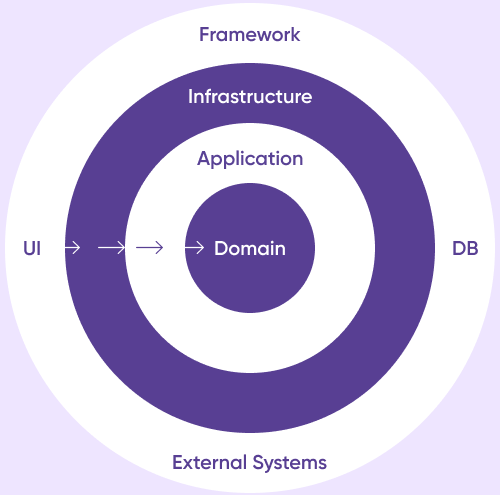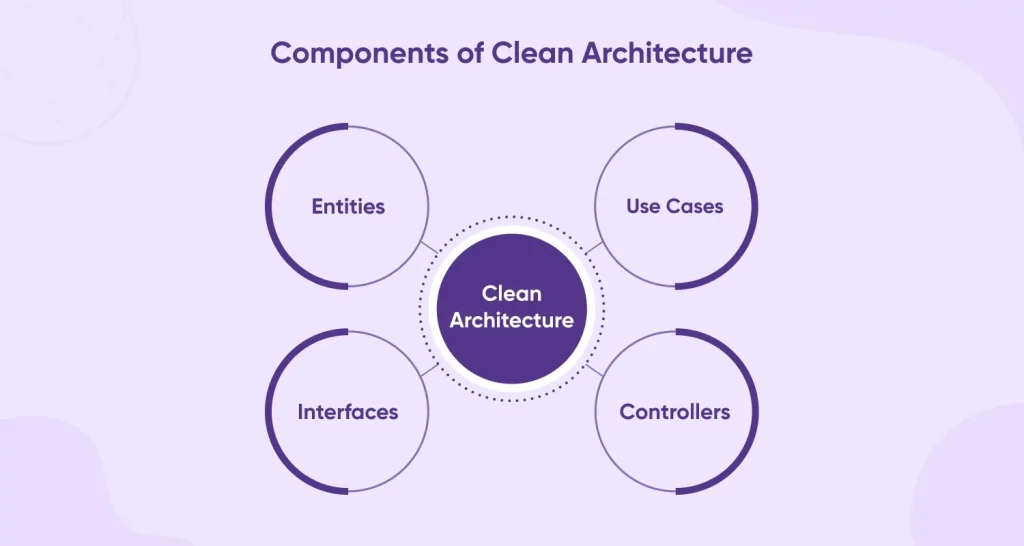Clean architecture .NET Core is a modern software development approach that prioritizes maintainability, testability, and flexibility. It’s a framework that separates the application’s core logic from its implementation details, making it easier to update and modify the system over time.
Clean architecture .NET Core provides several benefits to developers, including separation of concerns, testability and maintainability, and flexibility and scalability. This approach involves several components, such as entities, use cases, interfaces, and controllers, as well as four layers, including presentation, application, domain, and infrastructure.
In this article, we’ll explore what clean architecture .NET Core is, its benefits, components, layers, and how to implement it in .NET Core. We’ll also discuss best practices to get the most out of clean architecture .NET Core and how it can help developers build robust, scalable, and maintainable applications.
What is Clean Architecture?
Clean architecture is a software development approach that emphasizes the separation of concerns and the independence of application components. It’s a framework that prioritizes maintainability, testability, and flexibility by separating the application’s core business logic from its implementation details.
Clean architecture aims to create an architecture that can withstand changes and modifications over time without affecting the entire system. It involves several components, such as entities, use cases, interfaces, and controllers, as well as four layers, including presentation, application, domain, and infrastructure.

Clean architecture promotes good coding practices and software design principles, making it easier to maintain and scale applications. In .NET Core architecture, clean architecture is becoming increasingly popular due to its benefits of testability, maintainability, and flexibility. Clean architecture .NET Core is designed to build robust, scalable, and maintainable applications using .NET Core.
Benefits of Clean Architecture
Clean architecture has several benefits for developers, making it an increasingly popular approach in ASP.NET Development Company. Some of these benefits include:
- Separation of Concerns: Clean architecture separates the application’s core business logic from its implementation details, promoting the separation of concerns. This separation allows developers to focus on specific tasks without affecting other components of the application. This, in turn, makes it easier to maintain and update the system over time.
- Testability and Maintainability: Clean architecture promotes good coding practices and software design principles, making it easier to test and maintain the application. With clean architecture, developers can write automated tests that focus on the application’s core business logic, ensuring that it works as expected. This approach also allows developers to make changes and modifications without affecting the entire system.
- Flexibility and Scalability: Clean architecture is designed to be flexible and scalable. With its modular approach, developers can add new features or components to the system without affecting the existing codebase. This approach also makes it easier to scale the application as needed, allowing it to handle more users, data, and traffic.
Clean architecture provides several benefits to developers, including separation of concerns, testability and maintainability, and flexibility and scalability. These benefits make it an ideal approach for ASP.NET development companies looking to build robust, scalable, and maintainable applications.
Components of Clean Architecture

Clean architecture is a modular software development approach that involves several components, each with its own unique role in the system. In this section, we’ll explore the four main components of clean architecture and their respective roles:
- Entities: Entities are the central component of clean architecture. They represent the application’s core business logic and are responsible for encapsulating the application’s state and behavior. Entities are independent of the system’s implementation details, making them easier to test, maintain, and update over time.
- Use Cases: Use cases are the application’s specific business requirements. They represent a set of related actions or functions that the application performs. Use cases are implemented using the entities and are independent of the system’s implementation details, making them easier to test, maintain, and modify.
- Interfaces: Interfaces provide a way for different components of the system to communicate with each other. They represent the boundary between the application’s core business logic and its implementation details. Interfaces ensure that the application is modular and flexible, making it easier to modify and update over time.
- Controllers: Controllers are responsible for handling user input and interactions. They act as a bridge between the user interface and the application’s core business logic. Controllers are implemented using the interfaces, making them independent of the system’s implementation details.
Clean architecture includes entities, use cases, interfaces, and controllers, which work together to create a flexible and testable system. It’s vital to hire .NET Core developer who understands clean architecture best practices to develop scalable and maintainable applications.
Layers of Clean Architecture
Clean Architecture is a software development approach that emphasizes the separation of concerns and the independence of application components. It’s a framework that prioritizes maintainability, testability, and flexibility by separating the application’s core business logic from its implementation details. In this section, we’ll explore the four layers of Clean Architecture with ASP.NET Core and their respective roles.
Presentation Layer
The Presentation Layer is responsible for handling the user interface and presentation logic. It’s the layer that interacts with the user and provides a way for them to interact with the application. This layer is implement using ASP.NET Core, which provides a robust set of tools and libraries for creating user interfaces. The presentation layer is responsible for receiving user input and displaying the output, but it’s not responsible for the application’s business logic.
Application Layer
The Application Layer is responsible for implementing the application’s use cases. It acts as an intermediary between the presentation and domain layers and is responsible for executing the use cases by calling the appropriate domain layer methods. The Application Layer is also responsible for coordinating the flow of data between the presentation and domain layers. It’s implemented using C# classes and interfaces, and it should be independent of the presentation and infrastructure layers.
Domain Layer
The Domain Layer is the heart of the Clean Architecture. It’s responsible for implementing the application’s business logic and contains the entities and use cases. The Domain Layer is independent of the presentation and infrastructure layers and should only contain business logic that’s specific to the application. The Domain Layer is implemented using C# classes and interfaces, and it should be the most stable layer of the application.
Infrastructure Layer
The Infrastructure Layer is responsible for implementing the application’s infrastructure, such as databases, external APIs, and file systems. It’s the layer that interacts with external systems and provides a way for the application to persist data. The Infrastructure Layer is implemented using C# classes and interfaces, and it should be independent of the presentation and domain layers.
Clean Architecture with ASP.NET Core involves four layers: the Presentation Layer, Application Layer, Domain Layer, and Infrastructure Layer. These layers work together to create a modular and flexible system that is easy to test, maintain, and update over time. When hire ASP.NET developers, it’s important to ensure that they are familiar with this approach to ensure the development of high-quality, scalable, and maintainable applications.
Implementing Clean Architecture in .NET Core
Implementing Clean Architecture in .NET Core can be a daunting task for many developers, especially those who are new to the framework. However, with the right guidance, it’s a straightforward process that can yield significant benefits in terms of maintainability, testability, and flexibility. In this section, we’ll explore the steps involved in implementing Clean Architecture in .NET Core.
Setting up a New Project
The first step in implementing Clean Architecture in .NET Core is to set up a new project. This can be done using Visual Studio or the .NET CLI. When setting up the project, it’s essential to choose the right project template that supports Clean Architecture, such as the ASP.NET Core Web Application template with the “API” or “Empty” project configuration.
Creating the Layers and Components
Once the project is set up, the next step is to create the layers and components of Clean Architecture. This involves creating the four layers: Presentation, Application, Domain, and Infrastructure, and their respective components, such as entities, use cases, and interfaces. It’s essential to ensure that the layers are separated from each other and that the dependencies between the layers are inverted.
Implementing Dependency Injection
Dependency injection is a crucial aspect of Clean Architecture in .NET Core. It’s essential to ensure that the layers and components are loosely coupled and that the dependencies between them are injected using a dependency injection container, such as the built-in container provided by ASP.NET Core. This allows for easy testing and flexibility in changing the dependencies in the future.
Testing the Application
Testing is a critical aspect of Clean Architecture in .NET Core. It’s essential to ensure that the application is thoroughly tested at all levels, including unit tests, integration tests, and end-to-end tests. This ensures that the application is functioning as expected and that any changes made to the codebase do not affect the application’s functionality.
To successfully implement Clean Architecture in .NET Core, hiring experienced ASP.NET developers is crucial. They bring a solid understanding of software design principles, coding best practices, and working with ASP.NET Core, ensuring a smooth implementation process and a high-quality, maintainable application.

Best Practices for Clean Architecture
Clean Architecture is a popular approach to software development that emphasizes the separation of concerns and maintainability of code. While implementing Clean Architecture in .NET Core best practices that ensure the success of the project. In this section, we’ll explore some of the best practices for Clean Architecture .NET Core.
- Keeping the architecture simple: One of the most important best practices for Clean Architecture in .NET Core is to keep the architecture as simple as possible. This involves avoiding unnecessary complexity in the layers and components and sticking to the basic principles of Clean Architecture.
- Avoiding dependencies between layers: Clean Architecture emphasizes the inversion of dependencies between layers, which ensures that the layers are loosely coupled and independent of each other. It’s essential to avoid dependencies between layers, which can lead to tight coupling and make the codebase difficult to maintain.
- Writing clean and readable code: Clean Architecture promotes the writing of clean and readable code that is easy to understand and maintain. It’s essential to follow coding best practices, such as using meaningful variable and function names, commenting the code, and adhering to coding conventions.
- Regularly refactoring the codebase: Refactoring is a crucial aspect of Clean Architecture in .NET Core. It’s essential to regularly refactor the codebase to remove any redundancies, improve the code quality, and ensure that the code is maintainable over time. This involves identifying areas of the codebase that need improvement and making the necessary changes.
You may like this: Difference Between .Net Core and .Net Framework
Conclusion
In conclusion, Clean Architecture is an effective approach to software development in .NET Core, promoting maintainability, testability, and flexibility. By implementing Clean Architecture and following best practices, developers can create high-quality, maintainable, and scalable applications.
Frequently Asked Questions
What Are the Benefits of Clean Architecture in .Net Core?
Clean architecture in .NET Core offers benefits such as separation of concerns, testability, maintainability, flexibility, and scalability.
What Are the Four Layers of Clean Architecture?
The four layers of Clean Architecture are the presentation layer, application layer, domain layer, and infrastructure layer.
Is Clean Architecture Better than Mvvm?
Clean Architecture and MVVM are both effective architectural patterns, and the choice between them depends on the specific project requirements and goals.







